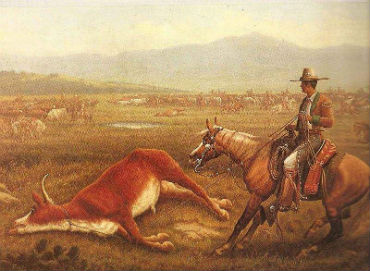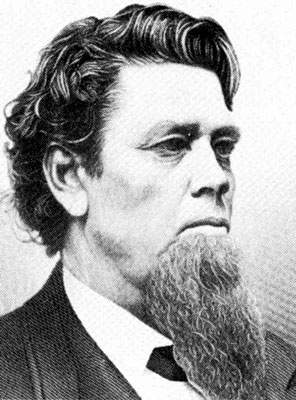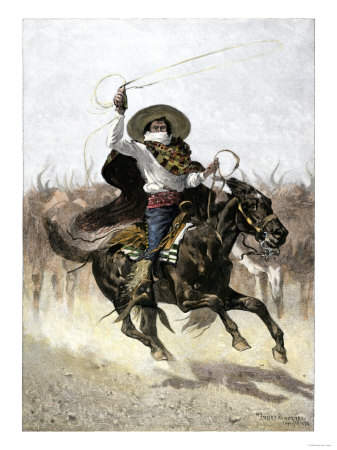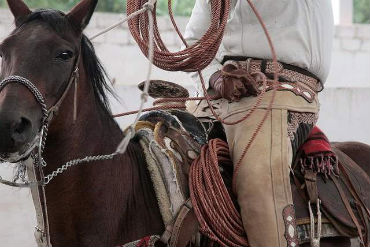Vaqueros
Teaching the world to rope and ride.
Ever since Tom Mix and his wonder horse Tony thundered across radio waves in the 1930s, Hollywood and the rest of the world have adopted the cowboy as the definitive portrait of Texas at its Wild West best.
Go to a rodeo today and take a look at the dusty icons of our heritage: cowboys and cowgirls in broad brimmed hats, leather boots, chaps, and jingling spurs. These cow pokes are probably twirling rawhide ropes, too – just waiting for a chance to fling the loop over a fleeing calf. More than a few people would look at that rodeo scene and tell you there's nothing more Texan than a cowboy or cowgirl. But that's not quite true. To be historically accurate, they'd have to say that there's nothing more North African-Spanish than a Texas cowboy. The tan-galóns, botas, chapareras, broncos, espuelas, and reatas belonging to today's cow folk are really the legacies of Texas's first real cowboys: the Mexican vaqueros. And the all-American rodeo? Vaquero through and through.
I wanted to become a vaquero and I did. Albert Rojas, author of These Were the Vaqueros
Roaming Contractors
The vaqueros didn't set out to become any kind of icons, either by clothing or skills. To the Spanish owners of big ranches in Mexico, the vaquero was a laborer. Most vaqueros were mestizo (of Native American and Spanish ancestry), American Indian, African American, mulatto, or criollo (a Spaniard born in North America). Vaqueros were early versions of independent contractors and weren't bound to a ranching hacienda or a patron unless they chose to be. Vaqueros owned their horses, saddles, and ropes and what they did with them would shape the history of Texas ranching.
Recruited by the King
Vaqueros had been herding and driving cattle and wild horses for hundreds of years by the time they became part of the Texas ranching landscape. The vaqueros were so renowned for their skills that rancher Richard King traveled to Mexico in 1854 to recruit entire vaquero families to manage his herds. King knew that these Mexican cowboys knew what to do with horses and cattle much better than he did. Seasoned vaqueros could stop a horse in its tracks or send it into a flat-out gallop with the slightest sway of the reins. The cowboys understood the social structure of cattle herds so well that they knew just where to look for the hiding strays. Their roping, riding, and ranching knowledge was unsurpassed.
King fed and housed the entire vaquero community on his ranch and paid the cowboys a monthly wage. Boys and girls went to a ranch school until they were old enough to learn to be a vaquero or vaquera. These families became known as Los Kineños— King's people— and through generations of service, they revolutionized the cattle business and helped build the King Ranch into the legend it is today.
"I was not afraid of anything, and loved working the cows. The men at the corrida would pick out a horse for me. The men were very respectful. I held the cows during branding and helped bring them in. We would change horses about two or three times a day. I wore a bush jacket, chaps, men's boots, a hat, and spurs."
- María Luisa Montalvo Silva, King Ranch vaquera
Not Just a Rope
For a 19th century vaquero, it was a close call as to what was most important: a horse or a rope. With a good horse, a vaquero was efficient. With a good reata, he was invincible. The reata was a vaquero's greatest source of pride. He made both his living and his reputation by how well he could throw it from the back of a galloping horse. It wasn't his horse but his reata that the vaquero protected first when the rains came, often stuffing it down his shirt to keep it dry and warm. Vaqueros were so particular about their long and limber ropes that they often made their own in a time-consuming processing of cutting, shaving, wetting, stretching, drying, greasing, and braiding strips of cowhide. When a vaquero had mastered tossing the hoop, the reata became an extension of his arm and was as effective in bringing down a cow as a cattle rustler.
A cowboy without a rope is like a man without arms. Albert "Lolo" Trevino, King Ranch vaquero
Mounted on a spirited pony, with a lasso at his saddle-bow, he is no mean adversary for a single man to encounter. He rides well and fearlessly, and throws the lasso with unerring aim. It is a beautiful sight to see him with his old blanket...streaming in the wind, his head bent eagerly forward, and lasso whirling in circles high in the air, chasing down some refractory animal that he seldom fails to catch, at the first throw... Captain George W. Hughes, U.S. Army San Antonio de Bexar in Texas, circa 1846
Riding, Roping, and Racing
The work of riding, roping, and herding meant long days and nights in the saddle, but when round-ups and trail drives were over, vaqueros relaxed and had fun…by riding and roping some more. Gathering in open fields, they competed against each other by racing horses and performing rope tricks, all to determine who was the most skilled. They leapt from horses to wrestle down a steer. They raced the clock for the shortest time to rope a calf and the longest time to stay on a bucking horse. They competed to keep their skills sharp and their reputations polished. Over time, crowds gathered to watch and cheer the vaqueros and their amazing feats.
"Never have I seen finer horsemanship than was there displayed by those whose task it was to pursue the animal and throw the lasso around the head or leg; and as often as most of those present had probably seen the feat performed, great was their enthusiasm when each vaquero brought down his victim."
- Harris Newmark, 1858
The vaqueros continued their competitions and the crowds got bigger. The nation became entranced by the dazzling demonstrations of roping skills and horsemanship. American cowboys and kids of all ages practiced throwing ropes around anything that moved. By 1929, the games of the working vaquero had transformed into America's favorite riding, roping, and racing event— the rodeo.
Vaqueros Haven't Vanished
You'll find vaqueros still flinging a rope around a cow or horse somewhere in Texas, California, the Big Sky Country and other parts of the U.S. They may be riding in trucks or helicopters and wearing baseball caps these days, but they're still vaqueros at heart. Vaqueros always.
Vaqueros siempre. vaquero saying
Vaqueros Timeline
The Spanish began making entradas into Texas in the 1690s. They intended to explore and expand into the far reaches of Spanish territory in order to buffer any encroachment from the French. From 1709 to 1722, the Spanish led roughly seven expeditions from Mexico to Texas. These early explorers brought cattle, sheep, and goats to the Texas frontier.
Ranching in Texas originated near San Antonio and Goliad in the 1730s. As the missions continued to fade into decline, individual ranchers became prominent due to generous land grants received from the Spanish Crown. One large ranch resulted from the Cavazos land grant, which was a sprawling 4,605 acres.
Once the Spanish formed an alliance with the Apaches, expansion of ranching lands became safer. Missions tended to have the best land, which put them in direct competition with the ranchers. Conflicts developed, and lawsuits between missions and ranchers became common at this time.
According to a newly enacted law, all wild animals and unbranded livestock were the property of the Spanish treasury. The law also established the "Mustang Fund" which imposed a tax on ranchers for all the branded livestock they rounded up.
Trade between Texas and Louisiana had been prohibited early in the 18th century. That ban was lifted in 1779. Ranching became more profitable as Spanish ranchers were able to drive their cattle along the Old San Antonio Road into the French territory of Louisiana. New Orleans soon became a major new market for ranchers.
Shortly after the trade ban was lifted in 1779, the Spanish colonial government reversed their decision because of the surge of smuggling. Since trade with Louisiana was hugely profitable, however, illicit trade continued. In a rare moment of unity, ranchers and missionaries became allies in their opposition to Spain's regulation of trade.
In 1785, rancher Juan José Flores submitted a document to the Spanish government in Mexico. Known as the San Fernando Memorial, the document argued that unbranded livestock belonged to ranchers since those animals were descended from the ranchers' animals. The government agreed and allowed the ranchers to collect and brand the animals.
Due to the San Fernando Memorial ruling, ranchers and missionaries planned a great round-up in 1787. La Bahia was the only mission to actually participate. As many as 7,000 cattle were captured and branded. This event marked a shift in the balance of power between ranchers and missionaries.
By 1795, ranchers were no longer required to pay the Mustang Fund taxes and were given one tax-free year to round up and brand wild livestock. This change in policy resulted in the increased transportation of cattle to markets in Louisiana and northern Mexico where they were sold for their tallow, hides, and meat.
Cattle herds became severely depleted because of continual predator attacks as well as the increased market demands for cattle products. The cattle industry declined and ranchers turned their money-making efforts toward a new livestock source— wild mustangs.
Stephen F. Austin established a settlement of Anglo Americans who found the ranching system in Texas in decline. The ranching knowledge and outstanding roping skills of vaqueros (Mexican cowboys) helped revive and rebuild the flagging ranching industry.
Following the end of the Civil War, the cattle industry began to rebound. Cattle were turned loose in south Texas and their populations rapidly increased. With cattle numbers on the rise again, ranchers drove their herds toward the new markets in the northern U.S. The cattle industry in Texas was back and booming.
From People Across Texas
More Texas History Stories or go back to the Bullock Terrazzo
- Vaqueros 1519-present
- African Americans 1821-1865
- American Indians BCE- 1600
- Buffalo Soldiers 1850-1880
- Cattle Ranchers 1850-1880s
- Conquistadors 16th Century
- Frontier Folk 1820-1850
- Missionaries 1500-1750
- Roughnecks 1890-1950
- Texas Rangers 1821-Present
- Women Airforce Service Pilots (WASP) World War II



